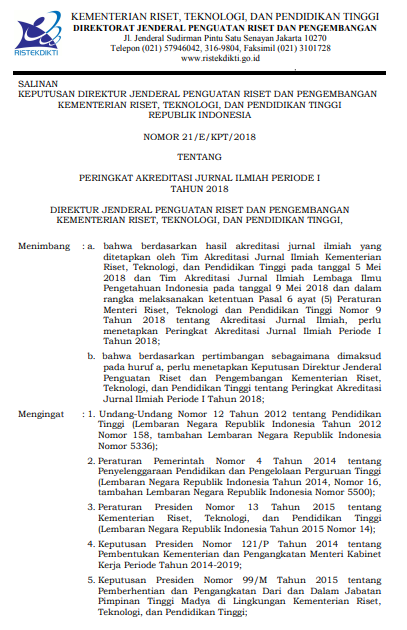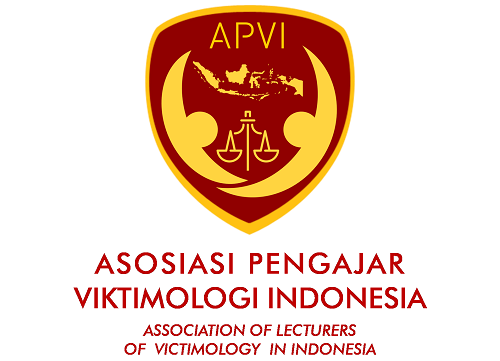Legal Compliance On The Road As The Effort To Overcome Jakarta’s Traffic Congestion
Abstract
Traffic discipline is an important attitude. Road drivers need to be accustomed to it if they want to reach their destination safely. Drivers need to be disciplined regarding regulation. Jakarta is a densely populated city with the problem of traffic congestion due to its road users who do not comply with regulations. Why are the people of Jakarta not discipline in traffic? What is the solution to make them obey traffic rules? These are main problems discussed in this paper. The research used the normative method, analyzed descriptively, used primary data which was supported by secondary data, and processed qualitatively. Jakarta people are not disciplined in traffic because there is no awareness about the importance of traffic order. As solutions, there
must be a strict law enforcement on the road, and officers must keep providing information to the public on the importance of traffic order. There must be sanction as a deterrent effect for those who are not disciplined in traffic.
Keywords: legal compliance; law enforcement; traffic order.
Full Text:
PDF View
References
Abenoza, R.F., Cats, O., Susilo, Y., (2017). Travel satisfaction with public transport: Determinants, user classes, regional disparities and their evolution. Transp. Res. Part A 95. 64–84.
Armstrong, R. J., & Rodríguez, D. A. (2006). An Evaluation of the Accessibility Benefits of Commuter Rail in Eastern Massachusetts using Spatial Hedonic Price Functions.
Transportation, 33(1), 21–43. http://doi.org/10.1007/s11116-005-0949-x
Anggraini, D. (2013). Studi Tentang Perilaku Pengendara Kendaraan Bermotor di Kota
Samarinda, Sosiatri-Sosiologi, 1 (1). 10-19. Accessible at http://ejournal.sos.fisipunmul.org
Apeeldorn. (2011). Pengantar Ilmu Hukum. Jakarta: Pradnya Paramita
Atkinson, R.C. (2005). Pengantar Psikologi. Ed.8. Jakarta: Penerbit Erlangga
Bae, C.-H. C., Jun, M.-J., & Park, H. (2003). The impact of Seoul’s subway Line 5 on
residential property values. Transport Policy. 10 (2), 85–94. http://doi.org/10.1016/
S0967-070X(02)00048-3.
Banister, D., & Thurstain-Goodwin, M. (2011). Quantification of the non-transport benefits
resulting from rail investment. Journal of Transport Geography, 19(2), 212–223.
http://doi.org/10.1016/j.jtrangeo.2010.05.001
Bollinger, C. R., & Ihlanfeldt, K. R. (1997). The Impact of Rapid Rail Transit on Economic
Development: The Case of Atlanta’s MARTA. Journal of Urban Economics, 42(2), 179–
Buamona, M. S., Et.all. (2017). Analisis Pelayanan Transportasi Angkutan Kota
di Kota Ternate. Spasial. 4 (3). 82-95.
Cats, O., Abenoza, R.F., Liu, C., Susilo, Y. (2015). Identifying priority areas based on a
thirteen years evolution of satisfaction with public transport and its determinants.
Transp. Res. Rec. 2538, 86–95.
Cervero, R., & Kang, C. D. (2011). Bus rapid transit impacts on land uses and land values in
Seoul, Korea. Transport Policy, 18 (1), 102–116. http://doi.org/10.1016/j.tranpol.2010.
005.
Chrussiawanti, N. (2015). Hubungan tingkat pengetahuan dengan kepatuhan safety riding
pada remaja di SMA Negeri 2 Sukoharjo. Surakarta: Sekolah Tinggi Ilmu Kesehatan
Kusuma Husada. Retrieved at http://digilib.stikeskusuma.ac.id
Currie, G., & Delbosc, A. (2011). Understanding bus rapid transit route ridership drivers:
An empirical study of Australian BRT systems. Transport Policy, 18(5), 755–764.
http://doi.org/10.1016/j.tranpol.2011.03.003.
Currie, G., & Delbosc, A. (2013). Exploring Comparative Ridership Drivers of Bus Rapid
Transit and Light Rail Transit Routes. Journal of Public Transportation, 16(2), 47–65.
http://doi.org/10.5038/2375-0901.16.2.3.
Deng, T., Nelson, J.D. (2012). The perception of Bus Rapid Transit: a passenger survey from
Beijing Southern Axis BRT Line 1. Transp. Plann. Technol. 35 (2), 201–219.
Eboli, L., Mazzulla, G. (2009). A new customer satisfaction index for evaluating transit
service quality. Public Transp. 12 (3), 21–38.
Fadaei, M., Cats, O. (2016). Evaluating the impacts and benefits of public transport design
and operational measures. Transp. Policy. 48, 105–116.
Ewing, G., Sarigollu, E., 2000. Assessing consumer preferences for clean-fuel vehicles: a
discrete choice experiment. J. Public Policy Market. 19 (1), 106–118.
Feldman, R.S. (2003). Essentials of Understanding Psychology. New York NY:Mc
Gusnita, D. (2010). Green Transport: Transportasi Ramah Lingkungan dan Kontribusinya
dalam Mengurangi Polusi Udara. Berita Dirgantara, 11 (2). 66-71.
Hendratno, ET. (2009). Masalah Transportasi Kota Dilihat Dengan Pendekatan Hukum,
Sosial dan Budaya. Jurnal Mimbar Hukum 21 (3). 494-506.
Hess, D. B., Yoh, A., Iseki, H., & Taylor, B. (2002). Increasing transit ridership: a survey of
successful transit systems in the 1990s. Journal of Public Transportation, 5 (3), 33-66.
Hutabarat, LB.C. (2017). Media Indonesia. Accessible at http://raw-Hillmm.mediaindo
nesia.com
Ingvardson, Jesper Blafoss and Nielsen, Otto Anker. (2017). Effects of New Bus and Rail
Rapid Transit Systems – an International Review. Transport Review. March. DOI:
1080/01441647.2017.1301594.
Kadarisman, M. Et.all. (2016). Kebijakan Manajemen Transportasi Darat dan Dampaknya
Terhadap Perekonomian Masyarakat di Kota Depok. Jurnal Manajemen Transportasi
& Logistik (JMTranslog). 3 (1). 41-58.
Kartono, K. (1996). Psikologi Umum. Bandung: Mandar Maju.
Knowles, R. D., & Ferbrache, F. (2015). Evaluation of wider economic impacts of light rail
investment on cities. Journal of Transport Geography. http://doi.org/10.1016/
j.jtrangeo.2015.09.002.
Levinson, H., Zimmerman, S., Clinger, J., & Gast, J. (2003). Bus Rapid Transit: Synthesis of
Case Studies. Transportation Research Record: Journal of the Transportation
Research Board, 1841, 1–11. http://doi.org/10.3141/1841-01.
Levinson, H., Zimmerman, S., Clinger, J., & Rutherford, G. (2002). Bus Rapid Transit: An
Overview. Journal of Public Transportation, 5(2), 1–30. http://doi.org/10.5038/23750901.5.2.1.
Maspupa. (2015). Perilaku Aparat Kepolisian Angka Kecelakaan Kendaraan Bermotor Di
Kota Pontianak. PublikA, Jurnal Ilmu Administrasi Negara. 3(4). 1-11.
Natawidjaja, R. (1977). Memahami Tingkah Laku Sosial. Jakarta: FA.Hasmar.
Nugroho, D.A & Arifin, S. (2016). Pengaruh Usia, Pendidikan dan Budaya Terhadap
Kepatuhan Lalu Lintas di Wilayah Hukum Polres Jepara. The 3
rd
University Research
Colloquium. 227-233. ISSN 2407-9189. Accessible at http://publikasiilmiah.ums.ac.id
Petty, F.MA. (1982). Pengantar Psikologi Umum. Surabaya: Usaha Umum.
Puspitasari, H. & Sardjito. (2014). Peningkatan Pelayanan Bus Transjakarta Berdasarkan
Preferensi Pengguna (Studi Kasus: Koridor I Blok M – Kota Jakarta. Jurnal Teknik
Pomits. 3 (1). 12-15.
Rianti, P.Y & Tuti, R.WD. (2017). Kualitas Pelayanan Transjakarta Busway di DKI Jakarta.
Jurnal Swatantra 15 (2). 161-169.
Sadono, S. (2017). Budaya Disiplin dalam Berlalu lintas Kendaraan Roda Dua di Kota
Bandung. Jurnal Progresif. 12 (1). 434-462.
Salam, B. (1997). Etika Sosial Asas Moral dalam Kehidupan Manusia. Jakarta: PT.Rineka
Cipta
Sarwono, SW. & Eko AM. (2012). Psikologi Sosial. Jakarta: Salemba Humanika.
Stokenberga, A. (2014). Does Bus Rapid Transit Influence Urban Land Development and
Property Values: A Review of the Literature. Transport Reviews. 34 (3). 276–296.
http://doi.org/10.1080/01441647.2014.902404.
Susilo, Y., Cats, O. (2014). Exploring key determinants of travel satisfaction for multimodal
trips by different traveler groups. Transp. Res. Part A: Policy Pract. 67, 366–
Tahir, A. (2005). Angkutan Massal Sebagai Alternatif Mengatasi Persoalan Kemacetan Lalu
Lintas Kota Surabaya. Jurnal SMARTek. 3 (3). 169-182.
Volinski, Joel. (2018). Reflection on the Future of Public Transportation. Journal of Public
Transportation. 21 (1). ii-vi. http//dx.doi.org/10.5038/2375-0901.21.1.13
Widowati, H. (2018). “Berapa Jumlah Kendaraan di DKI Jakarta?”. Katadata.co.id Retrieved
from: https://databoks.katadata.co.id/datapublish/2019/08/02/berapa-jumlahkendaraan-di-dki-jakarta#:~:text=Berdasarkan%20data%20Statistik%20Transporta
si%20DKI,tahun%20pada%20periode%202012%2D2016.&text=Jika%20diasumsikan
%20pertumbuhan%20mobil%20penumpang,menjadi%203%2C99%20juta%20unit
DOI: http://dx.doi.org/10.20884/1.jdh.2019.19.3.2601
Refbacks
- There are currently no refbacks.
JURNAL DINAMIKA HUKUM Indexed by :
 | Jurnal Dinamika Hukum | |
| Faculty of Law, Universitas Jenderal Soedirman | Copyright of Jurnal Dinamika Hukum | |
| Yustisia IV Building, Law Journal Center | ISSN 2407-6562 (Online) ISSN 1410-0797 (Print) | |
| Purwokerto, Central Java, Indonesia, 53122 | JDH is licensed under a Creative Commons Attribution 4.0 International License | |






